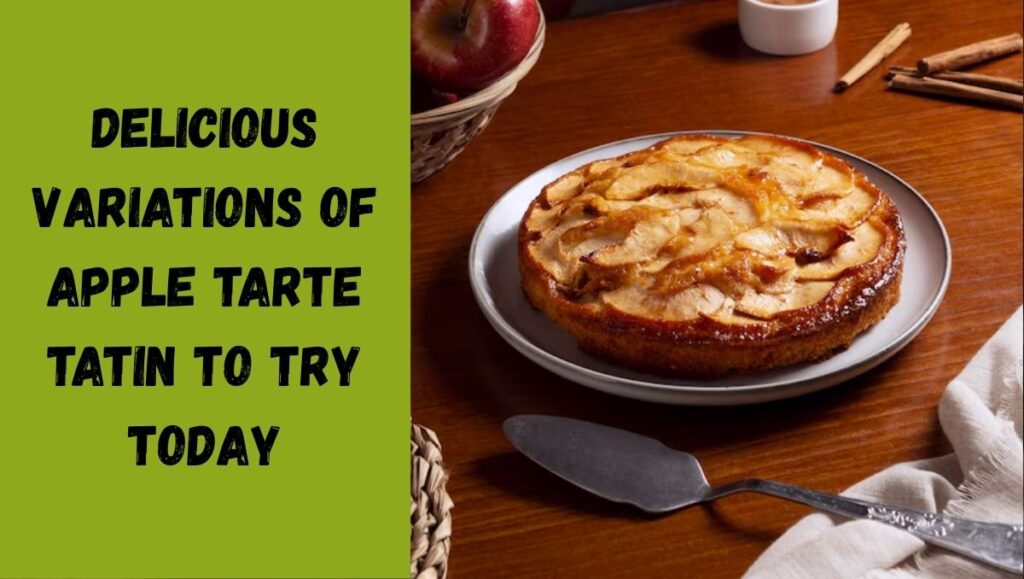Apple Tarte Tatin is a dessert that beautifully exemplifies the harmony between rustic charm and sophisticated technique. Its dramatic presentation — apples caramelized in rich butter and sugar, then topped with crisp pastry and flipped to reveal a glossy golden crown — is as much a feast for the eyes as it is for the palate. This upside-down tart embodies the essence of French provincial cuisine, using simple ingredients to create layers of complex flavor.
The balance between the tartness of the apples, the buttery sweetness of the caramel, and the flaky texture of the pastry creates an indulgence that feels both hearty and refined. Beyond the recipe, the Tarte Tatin’s origin story and versatility make it a dish worth mastering for any dessert enthusiast or home cook passionate about French gastronomy.
The Fascinating History and Cultural Significance of Tarte Tatin
The Apple Tarte Tatin’s history begins in the late 19th century at the Hôtel Tatin in Lamotte-Beuvron, where the Tatin sisters crafted a dish that became a beloved French culinary icon. Its origin story, often recounted as an accidental creation, reflects the French spirit of transforming kitchen mishaps into masterpieces. Stéphanie Tatin’s decision to invert her caramelized apples under a pastry crust rather than discard the overcooked fruit resulted in a tart with deep caramel flavors and an unforgettable texture.
This tale is a testament to the ingenuity and resourcefulness found in traditional French country cooking. The tart’s subsequent popularization by chefs like the legendary Auguste Escoffier helped it transcend regional roots to achieve global recognition. Today, Apple Tarte Tatin represents more than dessert; it is a cultural symbol of French hospitality, seasonality, and culinary creativity.
Selecting the Perfect Apples: The Science Behind the Fruit
Choosing the right apple variety is fundamental for a successful Tarte Tatin, where texture and flavor dramatically influence the final product. Apples for this tart must retain their shape during caramelization and baking to avoid a mushy outcome. This requirement is due to the cooking process, which softens the fruit as it absorbs the butter-sugar caramel. Granny Smith apples are often recommended for their firm flesh and bright acidity, which cuts through the richness of the caramel.
Braeburns offer a balanced sweet-tart flavor and maintain crispness. Other varieties like Pink Lady and Honeycrisp add subtle sweetness and a juicy texture, though their softer flesh means they cook faster. Understanding the sugar and acid content in apples can help predict how they will behave in the caramelization process, allowing bakers to select the best fruit to balance flavor, texture, and presentation.
The Art and Chemistry of Caramelization in Apple Tarte Tatin
Caramelization is the transformative process at the heart of Tarte Tatin, where sugar molecules break down under heat to develop complex flavors and colors. When sugar is heated, it melts and undergoes a series of chemical reactions known as the Maillard reaction and caramelization, creating a rich, amber-colored syrup with nutty, toffee-like aromas. The addition of butter introduces milk solids and fat, enriching the caramel’s flavor and providing a smooth mouthfeel.
Achieving the perfect caramel requires careful temperature control, typically between 320°F and 350°F (160°C to 177°C). Too low, and the caramel remains pale and bland; too high, and it burns, producing bitterness. The tactile sensation and flavor of the caramelized apples depend on this delicate balance. Mastery of this step is crucial for the tart’s signature glossy finish and deep, layered sweetness.
Preparing the Dough: Choosing and Handling Pastry for Tarte Tatin
The pastry topping plays a pivotal role in Apple Tarte Tatin, providing texture contrast and structural integrity. Traditionally, shortcrust pastry (pâte brisée) is used for its tender, crumbly texture that complements the juicy apples. This dough is made from flour, butter, a pinch of salt, and cold water, requiring gentle handling to avoid developing gluten, which would make it tough.
Some variations use puff pastry, which offers a lighter, flakier crust but may absorb more moisture, leading to sogginess if not handled properly. For shortcrust, chilling the dough before rolling helps prevent shrinkage and maintains flakiness. Blind baking the crust briefly can also reduce sogginess. Techniques like docking (pricking the dough with a fork) allow steam to escape during baking, preserving texture. Whether homemade or store-bought, the pastry choice affects the tart’s final flavor, texture, and presentation.
Detailed Step-by-Step Recipe for Classic Apple Tarte Tatin
To create a classic Apple Tarte Tatin, start by peeling and coring six to eight medium-sized apples. Halve the apples to ensure even cooking. In a heavy ovenproof skillet, melt 100g butter with 150g granulated sugar over medium heat, allowing the sugar to dissolve and caramelize to a golden amber hue, approximately 8-10 minutes. Avoid stirring once the sugar begins to melt; instead, gently swirl the pan.
Arrange the apple halves snugly in the caramel, rounded side down, packing tightly to create an attractive mosaic. Allow the apples to cook in the caramel for 15 minutes on low heat. Roll out chilled shortcrust pastry to about 3mm thickness, cutting a circle larger than the skillet. Place the pastry over the apples, tucking edges down around the fruit. Bake in a 190°C (375°F) preheated oven for 30-35 minutes until pastry is golden. Remove from oven, rest for 5 minutes, then carefully invert onto a serving plate. Serve warm with crème fraîche or vanilla ice cream.
Mastering Advanced Techniques for Tarte Tatin Perfection
Beyond the basic recipe, advanced bakers can elevate Apple Tarte Tatin through several techniques. For an even caramel layer, clarify the butter by removing milk solids, which helps prevent burning and yields a cleaner caramel flavor. Infusing the caramel with aromatics like vanilla bean, star anise, or a cinnamon stick during cooking imparts subtle complexity. Controlling caramel thickness by adjusting sugar quantities or adding a touch of water can help achieve desired viscosity.
For a richer crust, incorporate ground almonds or hazelnuts into the dough. When flipping the tart, use a wide, flat spatula and a second plate to avoid spillage, flipping quickly but carefully. Experimenting with cooking times allows fine-tuning apple softness and caramel consistency. Using a thermometer ensures caramel reaches the perfect temperature. These refinements transform a good tart into a sublime culinary experience.
Creative Variations and Flavor Enhancements
Apple Tarte Tatin’s classic profile invites endless creative variations. Incorporate seasonal fruits such as pears, quinces, or even figs, adjusting cooking time based on fruit firmness. Add a layer of frangipane almond cream beneath the apples for added texture and nutty richness. Experiment with savory twists by sprinkling thyme or rosemary on the apples or caramel for an herbaceous note.
For a festive touch, add a splash of Calvados or brandy to the caramel, igniting it carefully for a flambé effect that adds warmth and depth. Top with toasted nuts or a drizzle of salted caramel sauce for texture and balance. Incorporate citrus zest like orange or lemon into the caramel for brightness. Such adaptations allow bakers to tailor the tart to different occasions and palates, expanding its appeal.
Serving, Storing, and Reheating Apple Tarte Tatin
Apple Tarte Tatin is best enjoyed warm to fully appreciate the contrast between the crisp pastry and soft caramelized apples. Serve it alongside lightly whipped cream, crème fraîche, or vanilla ice cream to balance the richness. For special occasions, plate with a dusting of powdered sugar and a sprig of fresh mint for a polished presentation. Leftovers can be stored in the refrigerator, covered loosely, for up to 2 days.
Reheat gently in a warm oven (around 150°C/300°F) to restore the crispness of the pastry without melting the caramel excessively. Avoid microwaving, which can make the crust soggy and caramel runny. Apple Tarte Tatin can also be frozen; wrap tightly and thaw overnight in the refrigerator before reheating. Proper storage preserves texture and flavor, allowing enjoyment over multiple sittings.
Nutritional Analysis and Healthier Modifications
While Apple Tarte Tatin is a decadent dessert, understanding its nutritional content can help manage portion sizes and modifications. A typical serving contains approximately 350-450 calories, with high fat content from butter and sugar contributing to richness and texture. Apples add fiber, vitamin C, and antioxidants, beneficial for health. For a lighter version, reduce sugar by half or substitute with natural sweeteners like maple syrup or coconut sugar, though caramel flavor and consistency will vary.
Using whole wheat flour for the crust adds fiber and nutrients but may alterthe texture. Reducing butter or using plant-based alternatives can decrease saturated fat. Incorporating fruit purees into the dough can add moisture and sweetness naturally. These adjustments help balance indulgence with nutrition, allowing a wider audience to enjoy this classic French tart mindfully.
Apple Varieties for Tarte Tatin: Detailed Comparison Table
| Apple Variety | Flavor Profile | Texture When Cooked | Ideal Usage in Tarte Tatin | Notes |
|---|---|---|---|---|
| Granny Smith | Tart, slightly sour | Firm | Classic, holds shape well | Best for contrast with caramel sweetness |
| Braeburn | Balanced sweet-tart | Crisp | Great balance, versatile | Adds complexity to flavor |
| Honeycrisp | Sweet, mildly tart | Juicy, tender | Sweeter option, softer texture | Use with care, may cook faster |
| Golden Delicious | Sweet, mellow | Soft | For sweeter, softer tarts | Less acidity, rich sweetness |
| Pink Lady | Tart and sweet | Firm | Excellent flavor and firmness | Ideal for elegant presentations |
FAQ”s
What is the history behind the Apple Tarte Tatin and how did it become a French classic?
Apple Tarte Tatin originated in the late 19th century at the Hotel Tatin in Lamotte-Beuvron, France, created by the Tatin sisters. Legend has it that one sister accidentally caramelized apples in sugar and butter too long, then covered them with pastry and baked it upside down. The result was a delicious tart that became an instant hit. Over time, it grew in popularity and became a beloved French dessert known worldwide for its rich caramel flavor and rustic charm.
Which apple varieties are best for making a perfect Tarte Tatin?
The best apples for Tarte Tatin are firm, slightly tart varieties that hold their shape during cooking. Popular choices include Granny Smith, Golden Delicious, Braeburn, and Honeycrisp. These apples caramelize beautifully without becoming too mushy, providing the perfect balance of sweetness and texture in the tart.
What are the key steps to achieve the perfect caramelization without burning the sugar?
To achieve perfect caramelization, melt the sugar slowly over medium heat, stirring gently until it turns a rich amber color. Add butter carefully to create a smooth caramel sauce. Avoid stirring vigorously once the sugar starts melting to prevent crystallization. Keeping a close eye on the heat and timing is essential—too hot or too long will burn the caramel, while too low a temperature might not fully develop the flavor.


